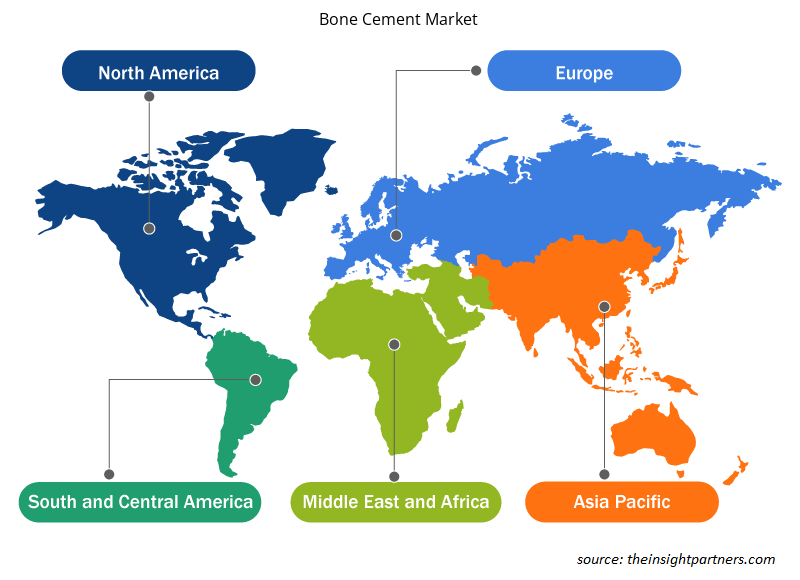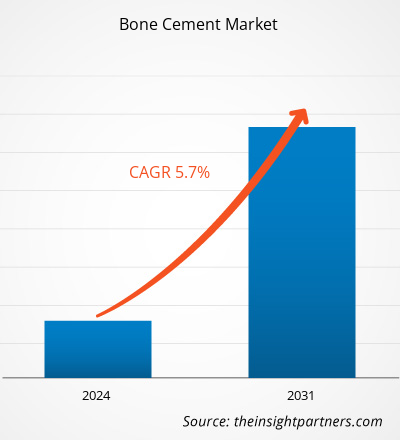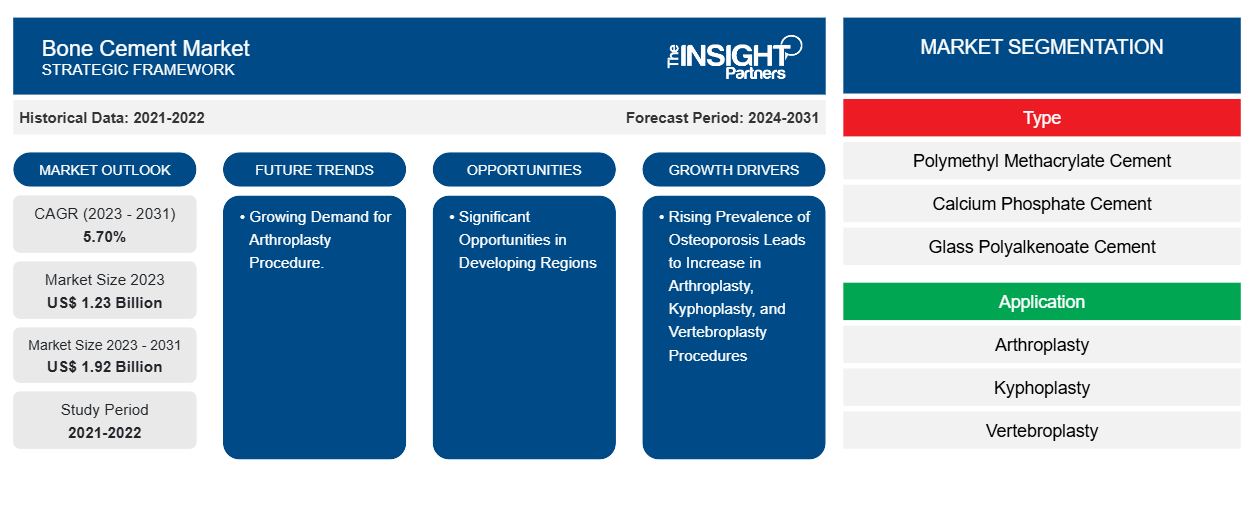Si prevede che la dimensione del mercato del cemento osseo raggiungerà 1,92 miliardi di dollari entro il 2031, rispetto agli 1,23 miliardi di dollari del 2023. Si prevede che il mercato registrerà un CAGR del 5,70% nel periodo 2023-2031.CAGR of 5.70% during 2023–2031. È probabile che il cemento osseo arricchito con antibiotici rimanga una tendenza chiave sul mercato.
Analisi del mercato del cemento osseo
La concorrenza tra gli attuali fornitori si rafforzerà a causa della maggiore attenzione rivolta allo sviluppo di cemento osseo con caratteristiche superiori, alta qualità e sicurezza, come il cemento osseo caricato con antibiotici per l'artroplastica e le fissazioni articolari ortopediche. Inoltre, il mercato si sta espandendo a causa della crescente accettazione di procedure come la cifoplastica, l'artroplastica e la vertebroplastica, che dovrebbero aumentare significativamente la crescita del mercato. Inoltre, si prevede che il mercato si espanderà a causa della crescente necessità di cemento osseo ortopedico e materiali per calchi, in particolare tra le persone anziane.
Panoramica del mercato del cemento osseo
L'alta frequenza dell'osteoporosi, la crescente necessità di cifoplastica, artroplastica e vertebroplastica e il forte aumento dell'invecchiamento della popolazione contribuiscono tutti all'espansione del mercato. Inoltre, le aziende hanno facilitato la loro crescita attraverso varie iniziative di sviluppo inorganico e organico. Le aziende hanno utilizzato varie strategie organiche per espandere le loro attività, come il lancio di prodotti. Le aziende hanno utilizzato tattiche inorganiche come partnership, fusioni e acquisizioni.
Personalizza questo report in base alle tue esigenze
Riceverai la personalizzazione gratuita di qualsiasi report, comprese parti di questo report, o analisi a livello nazionale, pacchetto dati Excel, oltre a usufruire di grandi offerte e sconti per start-up e università
-
Scopri le principali tendenze di mercato in questo rapporto.Questo campione GRATUITO includerà analisi di dati che spaziano dalle tendenze di mercato alle stime e alle previsioni.
Driver e opportunità del mercato del cemento osseo
La crescente prevalenza dell'osteoporosi porta ad un aumento delle procedure di artroplastica, cifoplastica e vertebroplastica, favorendo la crescita del mercato
Il rischio di fratture è aumentato dall'osteoporosi. I casi di osteoporosi sono aumentati negli ultimi anni. Ad esempio, l'International Osteoporosis Foundation afferma che quasi una donna su due intervistate ha subito una frattura correlata all'osteoporosi, rendendo queste fratture un grave problema di salute, e circa quattro milioni di persone nel Regno Unito soffrono di osteoporosi.
Opportunità significative nelle regioni in via di sviluppo
Si prevede che gli aumenti degli interventi di cifoplastica, artroplastica e vertebroplastica aumenteranno le vendite di cemento osseo. I principali partecipanti del settore aumentano le loro capacità produttive e ampliano le loro reti di distribuzione per migliorare la loro quota di mercato nelle economie in via di sviluppo. Per i principali produttori di cemento osseo, si prevede che i mercati emergenti in Corea del Sud, Messico, Brasile e India presenteranno prospettive di crescita. L'invecchiamento della popolazione, l'elevata prevalenza di osteoporosi, l'aumento del reddito disponibile, i migliori sistemi sanitari e l'espansione del turismo medico in queste nazioni creano opportunità redditizie. L'Asia Pacifica si è sviluppata in un hub flessibile e favorevole alle aziende. La maggior parte dei partecipanti sta rivolgendo la propria attenzione ai mercati emergenti man mano che i mercati statunitensi ed europei maturano. L'aggiornamento delle tecnologie più recenti nelle nazioni emergenti dipende in larga misura da significativi investimenti nella ricerca sulle scienze della vita e sulla salute. Ciò, a sua volta, rafforza la propensione all'uso del cemento osseo.kyphoplasty, arthroplasty, and
Analisi della segmentazione del rapporto di mercato del cemento osseo
I segmenti chiave che hanno contribuito alla derivazione dell'analisi di mercato del cemento osseo sono tipologia, applicazione e utente finale.
- In base al tipo, il mercato del cemento osseo è suddiviso in cemento di polimetilmetacrilato (PMMA), cemento di fosfato di calcio (CPC) e cemento di polialchenoato di vetro (GPC). Il segmento del cemento di polimetilmetacrilato (PMMA) ha detenuto la quota di mercato più significativa nel 2023.polymethyl methacrylate (PMMA) cement, calcium phosphate cement (CPC), and glass polyalkenoate cement (GPC). The polymethyl methacrylate (PMMA) cement segment held the most significant market share in 2023.
- Per applicazione, il mercato è categorizzato in artroplastica, cifoplastica e vertebroplastica. Il segmento dell'artroplastica ha detenuto la quota maggiore del mercato nel 2023.arthroplasty, kyphoplasty, and vertebroplasty. The arthroplasty segment held the largest share of the market in 2023.
- In base all'utente finale, il mercato è segmentato in ospedali, centri chirurgici ambulatoriali (ASCS) e cliniche. Il segmento ospedaliero ha detenuto la quota maggiore del mercato nel 2023.ASCS), and clinics. The hospitals segment held the largest share of the market in 2023.
Analisi della quota di mercato del cemento osseo per area geografica
L'ambito geografico del rapporto sul mercato del cemento osseo è suddiviso principalmente in cinque regioni: Nord America, Asia Pacifico, Europa, Medio Oriente e Africa, Sud e Centro America.
Il mercato del cemento osseo negli Stati Uniti detiene la quota maggiore tra i paesi del Nord America. La crescente incidenza dell'osteoporosi è il fattore principale che spinge l'espansione di questo mercato. Negli ultimi anni sono state segnalate numerose partnership e joint venture volte a far crescere il mercato statunitense del cemento osseo. Ad esempio, la Kyphon Products Division, una divisione del business Spinal and Biologics di Medtronic, ha raggiunto un traguardo significativo introducendo KYPHON ActivOs 10 Bone Cement con idrossiapatite nel mercato statunitense. Con il lancio di questo prodotto, il portafoglio di cemento di Medtronic offre ora ai chirurghi un'alternativa per il trattamento dei pazienti con fratture da compressione vertebrale (VCF). Pertanto, la recente introduzione del mercato del cemento osseo negli Stati Uniti probabilmente aiuterà la crescita della nazione.
Numerose aziende canadesi stanno implementando diversi approcci per espandere il settore del cemento osseo. Gli operatori del mercato hanno implementato varie strategie sostenibili, tra cui lanci di prodotti, espansione geografica, fusioni e acquisizioni e collaborazione strategica. Stryker, ad esempio, ha introdotto il cemento osseo simplex per fissare gli impianti in vari interventi chirurgici ortopedici e traumatologici.
Approfondimenti regionali sul mercato del cemento osseo
Le tendenze regionali e i fattori che influenzano il mercato del cemento osseo durante il periodo di previsione sono stati ampiamente spiegati dagli analisti di Insight Partners. Questa sezione discute anche i segmenti e la geografia del mercato del cemento osseo in Nord America, Europa, Asia Pacifico, Medio Oriente e Africa e America meridionale e centrale.

- Ottieni i dati specifici regionali per il mercato del cemento osseo
Ambito del rapporto sul mercato del cemento osseo
| Attributo del report | Dettagli |
|---|---|
| Dimensioni del mercato nel 2023 | 1,23 miliardi di dollari USA |
| Dimensioni del mercato entro il 2031 | 1,92 miliardi di dollari USA |
| CAGR globale (2023-2031) | 5,70% |
| Dati storici | 2021-2022 |
| Periodo di previsione | 2024-2031 |
| Segmenti coperti |
Per tipo
|
| Regioni e Paesi coperti |
America del Nord
|
| Leader di mercato e profili aziendali chiave |
|
Densità degli attori del mercato: comprendere il suo impatto sulle dinamiche aziendali
Il mercato del cemento osseo sta crescendo rapidamente, spinto dalla crescente domanda degli utenti finali dovuta a fattori quali l'evoluzione delle preferenze dei consumatori, i progressi tecnologici e una maggiore consapevolezza dei benefici del prodotto. Con l'aumento della domanda, le aziende stanno ampliando le loro offerte, innovando per soddisfare le esigenze dei consumatori e capitalizzando sulle tendenze emergenti, il che alimenta ulteriormente la crescita del mercato.
La densità degli operatori di mercato si riferisce alla distribuzione di aziende o società che operano in un particolare mercato o settore. Indica quanti concorrenti (operatori di mercato) sono presenti in un dato spazio di mercato in relazione alle sue dimensioni o al valore di mercato totale.
Le principali aziende che operano nel mercato del cemento osseo sono:
- Zimmer Biomet
- Sintesi DePuy
- Fabbro e nipote
- DJO Global, Inc
- Arthrex, Inc
Disclaimer : le aziende elencate sopra non sono classificate secondo un ordine particolare.

- Ottieni una panoramica dei principali attori del mercato del cemento osseo
Notizie e sviluppi recenti sul mercato del cemento osseo
Il mercato del cemento osseo viene valutato raccogliendo dati qualitativi e quantitativi dopo la ricerca primaria e secondaria, che include importanti pubblicazioni aziendali, dati associativi e database. Di seguito sono elencati alcuni degli sviluppi nel mercato del cemento osseo:
- OsteoRemedies(R) LLC, un'azienda ortopedica focalizzata sulla fornitura di soluzioni semplici per disturbi complessi, ha annunciato l'autorizzazione della FDA per indicazioni estese per il cemento osseo SPECTRUM(R) GV. L'indicazione estese riguarda la fissazione di componenti di artroplastica di revisione dell'anca, impiantati nella seconda fase di una revisione in due fasi dopo che l'infezione iniziale è stata eliminata. (Fonte: OsteoRemedies(R) LLC, comunicato stampa, aprile 2024)
- Zimmer Biomet ha vinto una causa presso la US International Trade Commission in cui è stata accusata di aver rubato segreti commerciali di Heraeus per il cemento osseo, il composto utilizzato per colmare lo spazio tra un'articolazione artificiale e un osso. La commissione ha respinto la richiesta di Heraeus Holding di bloccare le importazioni di cementi ossei Refobacin prodotti in Francia che competono con il prodotto PALACOS di Heraeus. (Fonte: Zimmer Biomet, comunicato stampa, gennaio 2021)
Copertura e risultati del rapporto sul mercato del cemento osseo
Il rapporto "Dimensioni e previsioni del mercato del cemento osseo (2021-2031)" fornisce un'analisi dettagliata del mercato che copre le seguenti aree:
- Dimensioni e previsioni del mercato del cemento osseo a livello globale, regionale e nazionale per tutti i principali segmenti di mercato coperti dall'ambito
- Tendenze del mercato del cemento osseo e dinamiche di mercato come fattori trainanti, vincoli e opportunità chiave
- Analisi dettagliata delle cinque forze PEST/Porter e SWOT
- Analisi del mercato del cemento osseo che copre le principali tendenze del mercato, il quadro globale e regionale, i principali attori, le normative e i recenti sviluppi del mercato.
- Analisi del panorama industriale e della concorrenza che copre la concentrazione del mercato, l'analisi della mappa di calore, i principali attori e gli sviluppi recenti per il mercato del cemento osseo
- Profili aziendali dettagliati
- Analisi storica (2 anni), anno base, previsione (7 anni) con CAGR
- Analisi PEST e SWOT
- Valore/volume delle dimensioni del mercato - Globale, Regionale, Nazionale
- Industria e panorama competitivo
- Set di dati Excel
Report recenti
Rapporti correlati
Testimonianze
Motivo dell'acquisto
- Processo decisionale informato
- Comprensione delle dinamiche di mercato
- Analisi competitiva
- Analisi dei clienti
- Previsioni di mercato
- Mitigazione del rischio
- Pianificazione strategica
- Giustificazione degli investimenti
- Identificazione dei mercati emergenti
- Miglioramento delle strategie di marketing
- Aumento dell'efficienza operativa
- Allineamento alle tendenze normative























 Ottieni un campione gratuito per - Mercato del cemento osseo
Ottieni un campione gratuito per - Mercato del cemento osseo